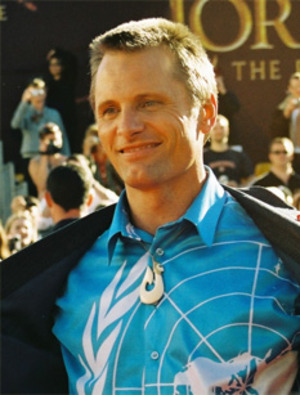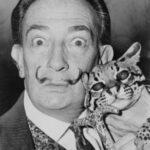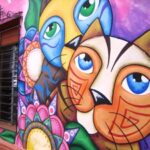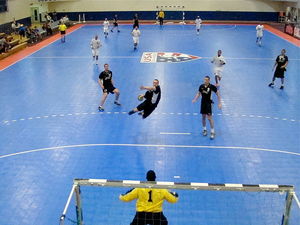When one thinks of the modern artist one may be reminded of Pablo Picasso, Salvador Dali, Andrew Warhol, of many other great modern artists. Those who fit into the category of modern artist, circa after 1800s, are plenteous. Still one can not help but question who are the artists rising to fame in the last ten years? Is there anyone in particular who is out there making a name, but not yet a household word? The resounding answer is yes! Many such people are rising to the top in the world of art. But, there is one person in particular, that may be a household name as a great actor, but not as a great artist. This person has shown his photographs and paintings in galleries across the United States of America, and globally. His name is Viggo Mortensen.
Viggo Mortensen is a very well known and critically acclaimed actor. In the last few years, he has gained much notoriety for his role as Aragorn in the Tolkien classic The Lord of the Rings, and the true story of Frank T. Hopkins (a pony express rider) in the movie “Hidalgo” (Stephen Cohen Gallery). His screen fame is phenomenal, but it has overshadowed his other artistic accomplishments.
Viggo was born on October 20, 1958 (Special Realms). “He was born on the Lower Eastside of Manhatten. His father Viggo Sr, was Danish, while his mother was American” (Tiscali). As a young child he lived in “Buenos Aires in Argentina, and Venezuela, often spending holidays back in Denmark on the family farm” (Special Realms). One cannot help but wonder how Viggo’s world travels influenced him and his artistic view of the world. His immersion in so many cultures at a young age had to have had a huge impact on his life.
Viggo has been described as being “an artistic kid, always to be seen with a pencil and paper on hand” (Tiscali). In 1969, Viggo moved back to New York state to the town of Watertown (Tiscali). It was there where he not only was armed with a pencil and paper, but it is where he began to “further his artistic interest” (Tiscali). It is said that he would “prowl the streets, snapping any person or scene that caught his eye. It was a habit he’d never relinquish (Tiscali).
Viggo has been referred to as a “celebrated artist who has had many successful gallery exhibits in New York, and Los Angeles” (Special Realms). These galleries and others have demonstrated how “he has spread himself over many art forms, his photos are of many genres, moods, and in many keys” (Danish Articles). He is a passionate artist that is not conformed to any traditional styles of art, or limited to any particular medium. “Viggo is ruled by the moment; motifs come to him not the other way around” (Danish Articles). His gallery exhibits drive home this point at every show.
This is evident in one of his gallery events at the Stephen Cohen Gallery. His exhibit entitled “Miyelo” “is compromised of a series of large-scale, panoramic photographs of a Lakota Ghost Dance “(Stephen Cohen Gallery). This exhibit is visionary and unique. It expresses a visionary side of the Ghost Dance, and it helps to lend a feeling of being in the presence of the dancer to the one who is viewing it.
Miyelo” is an interpretation of the Ghost Dance performed by Chief Big Foot’s band at Wounded Knee Creek on December 29,1890 (Stephen Cohen Gallery). He was evidentially inspired on the set of “Hidalgo” to capture these images. His stroke of inspiration has allowed many people to experience something that they could otherwise never see. For these pictures he used “long exposures to represent what was intended as a hallucination by a veteran of the Wounded Knee Creek Massacre, as shot in the California Desert in March 2003 got the movie “Hidalgo” (Stephen Cohen Gallery).
Viggo’s artistic vision has been described as having “the lack of a distinct style- a watermark that would make it possibly to speak of a “true Mortensen”- makes the exhibits interesting and diverse (Danish Articles). His love for all art processes has given him a wide view of interests.
Another gallery showing was entitled “Signlanguage”. It occurred in Santa Monica, California, on December 13, 2001 at the Track 16 Gallery (Track16). “Signlanguage” has been called an extraordinary look into the process and mind of artist whose boundless creative output touches a myriad of media and modes of expression: he is a photographer, painter, and poet” (Track 16).
Track 16 gallery described Viggo as liking “sotto voice details; he gives his attention to instants that would otherwise have passed by unobserved, or more signifigantly, unregistered.” His exhibit “Signlanguage” and his work in general, “suggests a view of life where experience has value without the artist intervening to rearrange and structure it. He does not seek out the shockingly strange but instead notices the sharp buzz of formal or color relationships, whether he is photographing the streets of L.A. or in New Zealand” (Track16).
Viggo does have a style that is all his own, and it is this style that allows him to join the ranks of modern artists such as Pablo Picasso, Salvador Dali, Warhol, and others. His paintings, are said to “relate to his photography in the sense that they also teem with lived incidents” (Track 16). His paintings are often times are “collages, brushings of materials and words” (Track 16). Viggo said about his paintings that “They are often painted over written over, sanded, rewritten, crossed out, re-painted, re-sanded, re-written, etc.” (Track 16). His paintings often enclude “words from his poems and found phrases [that] both succumb and survive as they enter the field of the canvas” (Tack 16).
His many gallery exhibits at the Robert Mann Gallery, Track 16 Gallery, Fototeca de Cuba, Musest for Fotokunst, Wellington City Gallery, and Massey University ensures he will get the attention his art deserves (Stephen Cohen). Viggo Mortensen has transcended his career as an actor and reached a level that is highly admirable and noteworthy. He is truly best described as “an artistic powerhouse” (Tiscali).
Bibliography
Danish Articles, (2003) Fyens Stiftidende, Seize the Day, Retrieved from the World Wide Web at: http://danisharticles.viggo-online.net/Art44.html.
Special Realms, (2005), The Many Faces of Viggo Mortensen, Retrieved from the World Wide Web at: http://www.specialrealms.com/VM/biography.html.
Stephen Cohen Gallery, (2003), Viggo Mortensen, Miyelo 4, 2003, Retrieved from the World Wide Web at: http://www.stephencohengallery.com/exhibits/exhib18.html.
Tiscali, (2005) Viggo Mortensen Biography, Retrieved from the World Wide Web at: http://www.tiscali.co.uk/entertainment/film/biographies/viggo_mortensen_biog.html.
Track 16 Gallery, (2002) Viggo Mortensen Signlanguage, Retrieved from the World Wide Web at: http://www.track16.com/exhibitions/viggo.





